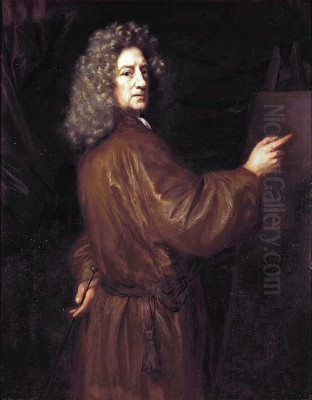
Nicolaes Maes (1634-1693) stands as a significant figure in the rich tapestry of the Dutch Golden Age of painting. Born in Dordrecht, a city with its own vibrant artistic scene, Maes navigated a path that led him from the dramatic intensity of his teacher, Rembrandt, to becoming one of the most sought-after portrait painters in Amsterdam. His journey reflects both the artistic currents of his time and a distinct personal evolution, leaving behind a legacy of captivating genre scenes and elegant portraits.
Early Life and Rembrandt's Tutelage
Nicolaes Maes was born in January 1634 in Dordrecht, the son of Gerrit Maes, a merchant, and Ida Herman Claesdr. Showing artistic promise at a young age, he moved to Amsterdam around 1648, likely at about the age of 14 or 15. This move was pivotal, as he entered the bustling studio of Rembrandt van Rijn, arguably the most famous Dutch artist of the era. This was a period when Rembrandt's workshop was a magnet for aspiring painters eager to learn from the master.
Maes spent approximately five years under Rembrandt's guidance, until about 1653. This formative period profoundly shaped his early artistic output. He initially focused on history painting, tackling religious and mythological subjects favored by his teacher. Works from this time clearly show Rembrandt's influence, characterized by dramatic use of chiaroscuro – the strong contrast between light and dark – and a palette dominated by warm, deep reds and browns. The emotional intensity and psychological depth often found in Rembrandt's work are echoed in Maes's early canvases.
Examples like Christ Blessing the Children (c. 1652-1653) and the painting sometimes identified as Jacob Receiving Joseph's Bloody Coat demonstrate this early allegiance to his master's style. These works employ the deep shadows and focused light sources typical of Rembrandt, creating a sense of intimacy and gravity. Maes absorbed the techniques but also began subtly adapting them, hinting at the independent artistic voice that would later emerge.
Return to Dordrecht and the Rise of Genre Painting
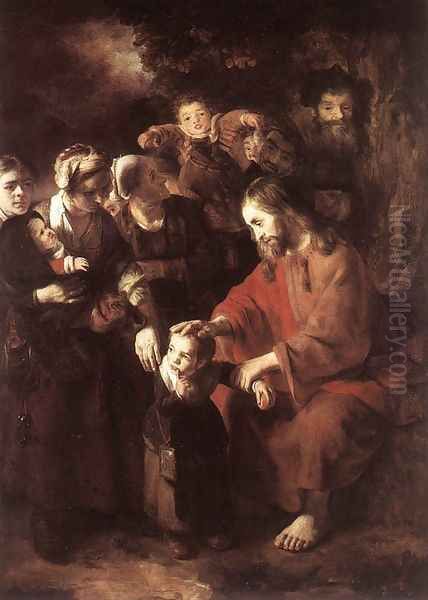
Around 1653, Maes left Rembrandt's studio and returned to his hometown of Dordrecht. He established himself as an independent master and married Adriana Brouwer, the widow of the preacher Arnoldus de Gelder. This period marked a significant shift in his subject matter. While he didn't entirely abandon historical themes, Maes increasingly turned his attention to genre painting, depicting scenes of everyday domestic life.
His Dordrecht genre scenes are considered among his finest achievements and represent a departure from the Rembrandtesque mode. While still employing skillful light and shadow, the overall mood often became less overtly dramatic and more focused on the quiet narratives of household activities. He developed a reputation for intimate portrayals of women engaged in tasks like lacemaking, reading, or minding children, often set within meticulously rendered Dutch interiors.
Works like The Idle Servant (also known as Interior with a Sleeping Maid and an Idle Servant, 1655), now housed in the Dordrechts Museum, exemplify this phase. It showcases his ability to construct a scene with convincing spatial depth, rich color, and a narrative element – contrasting the sleeping maid with the diligent housewife glimpsed in another room. The play of light filtering through windows became a hallmark, illuminating textures and creating atmosphere.
Other notable genre works from this period include An Old Woman Praying (c. 1655, National Gallery, London), The Weaver's Daughter (1656, National Gallery of Canada), and The Virtuous Woman (c. 1655, Wallace Collection, London). These paintings often carry moral undertones, celebrating domestic virtue or gently critiquing idleness, themes popular in 17th-century Dutch culture. Maes became particularly known for his "eavesdropper" scenes, like Man Peeping (1660s), where figures peer through doorways or down stairwells, drawing the viewer into a moment of voyeuristic intrigue.
His innovative compositions and sensitive handling of light in these domestic interiors are thought to have influenced other masters of Dutch genre painting, most notably Johannes Vermeer and Pieter de Hooch, who were also exploring similar themes of light and domesticity, albeit with their own distinct approaches. Maes's ability to capture the textures of fabrics, wood, and metal added a tangible realism to his scenes.
The Antwerp Interlude and Developing Style

Art historical records suggest that Maes might have spent some time in Antwerp between approximately 1665 and 1667, though this period is less documented than his time in Amsterdam or Dordrecht. If he did travel to Antwerp, the leading artistic center of the Southern Netherlands (Flanders), it would have exposed him directly to a different artistic tradition, one dominated by the legacy of Peter Paul Rubens and the elegant portraiture of Anthony van Dyck.
Antwerp's artistic climate was distinct from that of the Dutch Republic. Flemish art, particularly under Rubens and Van Dyck, often embraced a more exuberant, colorful, and aristocratic style compared to the often more restrained and burgher-focused art of the north. Van Dyck, in particular, had established an international reputation for his sophisticated portraits of royalty and nobility, characterized by graceful poses, luxurious fabrics, and an air of effortless elegance.
Exposure to this Flemish style, whether through a stay in Antwerp or through the circulation of prints and paintings, seems to have played a role in the gradual evolution of Maes's own art. While his genre painting period was highly successful, the seeds of a stylistic shift towards greater elegance and perhaps a brighter palette may have been sown during the mid-1660s, possibly influenced by these Flemish masters. This potential influence would become much more apparent in the final phase of his career.
Amsterdam and the Flourishing Portraitist
In 1673, Maes made a decisive move, relocating permanently to Amsterdam. He would remain there for the rest of his life. This move coincided with the final major shift in his artistic focus: he largely abandoned genre scenes and dedicated himself almost exclusively to portraiture. Amsterdam was the commercial and cultural heart of the Dutch Republic, and its wealthy merchant class, civic leaders, and elite families provided a booming market for portraits.
Maes quickly established himself as one of the city's leading portrait painters, competing with contemporaries but carving out a distinct niche. His style underwent a noticeable transformation. He moved away from the darker, more intimate manner of his earlier work and embraced a brighter, more colorful, and overtly elegant style. This later portrait style shows a clear affinity with the aristocratic flair of Anthony van Dyck, suggesting Maes consciously adapted elements of the Flemish master's approach to meet the tastes of his affluent Amsterdam clientele.
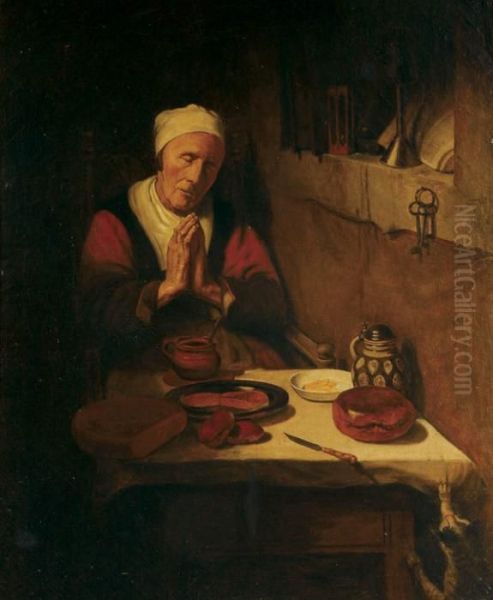
His portraits from this period feature sitters dressed in fashionable attire, often posed against landscape backgrounds or within opulent settings. He paid meticulous attention to rendering the textures of silks, velvets, and lace, using fluid brushwork and a richer, more varied palette than in his earlier phases. Works like the Portrait of a Young Lady (1682) demonstrate this mature style, with its sophisticated composition, delicate handling of light on fabric and flesh, and the sitter's poised demeanor.
Despite his success and prominence, Maes apparently never became a formal citizen (burgher) of Amsterdam. However, he did join the city's Guild of Saint Luke, the professional organization for painters and other craftsmen, indicating his integration into the city's artistic community. He became highly sought after, painting numerous individual and group portraits for Amsterdam's elite. His Self-Portrait from around 1685 (Dordrechts Museum) shows him presenting himself confidently, reflecting his status as a successful master.
Artistic Style Evolution - A Closer Look
The trajectory of Nicolaes Maes's artistic style is one of the most fascinating aspects of his career. It represents a journey across different genres and aesthetic sensibilities prevalent in the Dutch Golden Age. His initial phase was deeply indebted to Rembrandt, mastering the use of chiaroscuro for dramatic effect and exploring the emotional potential of religious and historical narratives. The deep, warm tones and concentrated light sources of this period are unmistakably Rembrandtesque.
The move back to Dordrecht prompted a significant thematic and stylistic shift. While retaining a masterful control of light, Maes applied it to the more intimate world of domestic genre. His palette remained relatively subdued compared to his later work, but his compositions became innovative, often using doorways and windows to create complex spatial arrangements and narrative layers. The focus shifted from grand biblical drama to the quiet moments and moral tales of everyday life, rendered with sensitivity and psychological insight.
The final phase, centered in Amsterdam and dedicated to portraiture, marked the most dramatic stylistic change. Influenced perhaps by Flemish elegance, particularly Van Dyck, and the demands of a sophisticated urban clientele, Maes adopted a brighter palette, more fluid brushwork, and a greater emphasis on decorative elements and fashionable display. The deep shadows of his youth gave way to clearer, more evenly distributed light, highlighting the luxurious textures of clothing and the social standing of his sitters. This later style was immensely popular, securing his reputation but sometimes drawing criticism from later commentators who preferred the perceived depth of his earlier work.
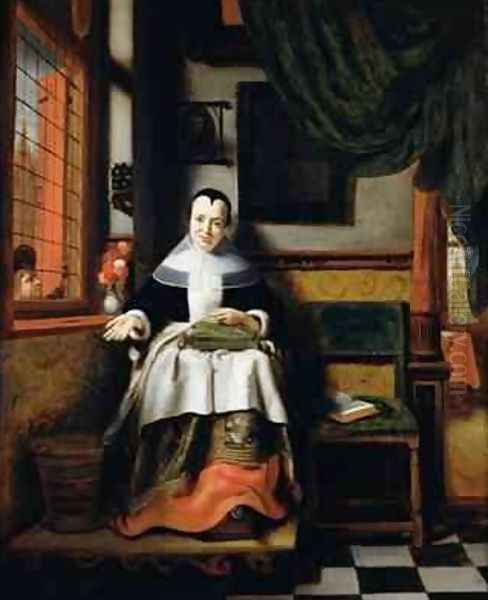
This evolution showcases Maes's versatility and responsiveness to different artistic contexts and market demands. He successfully navigated the transition from being a pupil of a dominant master like Rembrandt to forging his own path in genre painting, and finally reinventing himself as a fashionable portraitist, absorbing and adapting influences from artists like Van Dyck along the way.
Notable Works and Where to Find Them
Nicolaes Maes's oeuvre is well represented in major museums across the world. His works offer a visual journey through his evolving style and thematic interests.
Key early works showing Rembrandt's influence, such as Christ Blessing the Children (c. 1652-1653), can be found in collections like the National Gallery, London, which also holds other important pieces. The Portrait of a Young Noblewoman (c. 1650-1653), displaying early portrait characteristics, is housed in the Belvedere Museum in Vienna.
His celebrated Dordrecht genre period is exemplified by several key paintings. An Old Woman Praying (c. 1655) is a highlight at the National Gallery, London. The Dordrechts Museum, in his hometown, holds the significant Interior with a Sleeping Maid and an Idle Servant (1655) and his later Self-Portrait (c. 1685). The National Gallery of Canada in Ottawa houses The Weaver's Daughter (1656). The Wallace Collection in London preserves The Virtuous Woman (c. 1655), a fine example of his domestic scenes with moral dimensions.
His later Amsterdam portraits are also widely dispersed. Major Dutch collections, including the Rijksmuseum in Amsterdam and the Mauritshuis in The Hague, hold examples of his portraiture, showcasing his elegant later style. Exhibitions dedicated to Maes, such as those held at the National Gallery in London and the Mauritshuis, have brought together works from various phases, highlighting his development and contribution to Dutch art. The work titled Spanish Gypsy or Woman with Three Children and a Goat (c. 1653), an intriguing early piece, has appeared on the art market.
Contemporaries and Connections
Nicolaes Maes operated within a vibrant and competitive artistic landscape. His most significant connection was undoubtedly his teacher, Rembrandt van Rijn. Maes was among the most talented pupils to emerge from Rembrandt's workshop, alongside others like Govert Flinck and Ferdinand Bol, who also initially worked in a Rembrandtesque style before developing their own successful careers, primarily as portraitists.
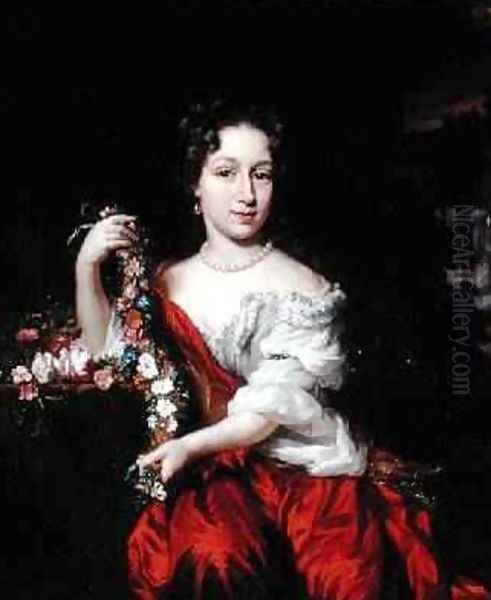
During his time in Dordrecht, Maes would have known other local artists. Samuel van Hoogstraten, another Rembrandt pupil who returned to Dordrecht, was a contemporary known for his experiments with perspective and illusionism, as well as genre scenes and portraits. The Cuyp family, particularly Jacob Gerritsz. Cuyp and his more famous son Aelbert Cuyp, were dominant figures in Dordrecht painting, known for landscapes and portraits.
In the realm of genre painting, Maes's work intersects with that of Johannes Vermeer and Pieter de Hooch. While direct influence is debated, Maes's innovative interior compositions and focus on domesticity predate some of the most famous works by Vermeer and De Hooch, suggesting he played a role in popularizing these themes. Other prominent genre painters of the era include Jan Steen, known for his lively and often humorous scenes, Gerard ter Borch, famed for his refined depictions of upper-class life, and Gabriel Metsu, whose detailed interiors share some affinities with Maes's work.
His later portrait style brought him into the orbit of Amsterdam's portrait specialists and showed the influence of Flemish masters like Peter Paul Rubens and especially Anthony van Dyck. In Amsterdam, he would have been aware of the work of portraitists like Bartholomeus van der Helst, who enjoyed enormous popularity for his smooth, detailed likenesses. Even the great portraitist Frans Hals, though primarily based in Haarlem and of an older generation, set a high bar for capturing likeness and personality. Maes successfully navigated this complex network of influences and competitors to become a leading master in his own right.
Mysteries, Anecdotes, and Unanswered Questions
Despite his prominence, aspects of Nicolaes Maes's life and work remain subjects of discussion and speculation among art historians.
The precise meaning and inspiration behind some early works, like the enigmatic Spanish Gypsy (or Woman with Three Children and a Goat), are unclear. Suggestions that it might illustrate a text by the popular Dutch writer Jacob Cats remain tentative, leaving the narrative open to interpretation.
The reasons behind his major stylistic shift in the 1660s and 1670s – moving decisively from genre painting to portraiture and adopting a much brighter, more elegant style – are not fully understood. Was it purely artistic evolution, a response to changing market tastes favoring the Van Dyckian mode, a desire for greater financial success (portraits were often lucrative), or perhaps even related to personal circumstances or health? The sources are silent on his motivations.
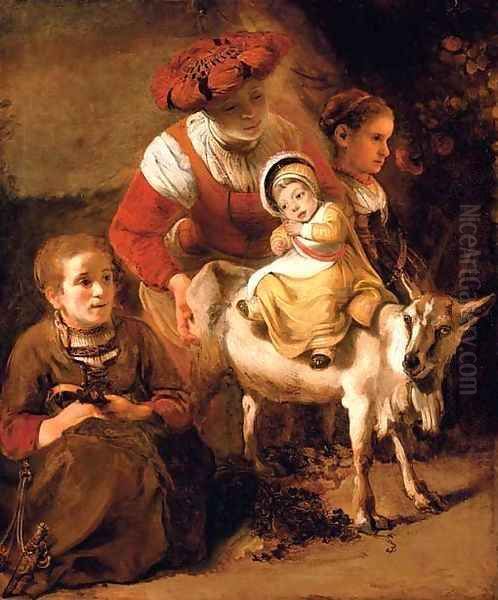
His later career was marked by a significant number of unfinished portraits. While this might simply reflect a busy studio struggling to keep up with demand, it has also been linked to his declining health. Maes suffered from gout, a painful condition that could have hampered his ability to paint consistently in his final years.
Attribution issues have occasionally surfaced. A painting titled The Sacrifice of Isaac, once attributed to Maes, was later reassigned to another (unnamed) Rembrandt student, highlighting the challenges of distinguishing hands within the master's circle. Conversely, a painting initially doubted by an auction house in Cirencester in 2007 was later confirmed as a genuine Maes after expert consultation, fetching a price far exceeding its estimate and demonstrating the ongoing process of authenticating works.
Details of his personal life remain sparse. We know he married Adriana Brouwer and was buried beside her in Amsterdam's Nieuwe Kerk, but little about their relationship or family life is recorded. The complex narrative and symbolism within his popular "eavesdropper" paintings continue to be debated, with scholars exploring the interplay of curiosity, morality, and domestic intrigue encoded in the gestures, expressions, and spatial arrangements. His relationship to Rembrandt's legacy also remains a point of discussion – was his later style a rejection of his master's principles or a logical adaptation to new circumstances?
Maes on the Market: Auctions and Value
Nicolaes Maes's works have long been appreciated by collectors and continue to perform well on the art market, reflecting his established position in the canon of Dutch Old Masters. Auction records and exhibition highlights underscore his enduring appeal.
For instance, a Portrait of a young noblewoman, handled by Frost & Reed, was sold at Sotheby's in New York in 2005 for $10,700, falling within its estimate, indicating steady market interest in his portraiture. More dramatically, the work titled Spanish Gypsy achieved a remarkable £4,110,000 at a Christie's auction in 2002, signifying the high value placed on his rare and compelling early works.
His paintings are also featured prominently in major art fairs. A Group Portrait of Virtue as Mirror of the World was noted as a highlight at the prestigious TEFAF Maastricht fair, demonstrating the desirability of his work among top-tier collectors and dealers.
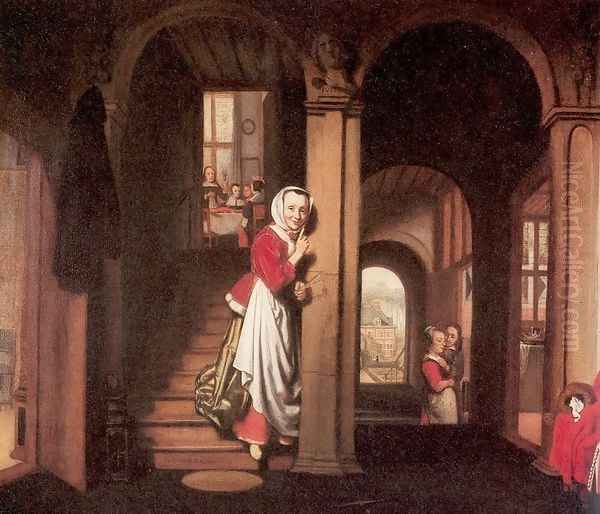
The aforementioned Cirencester auction incident in 2007 further illustrates the potential high stakes involved with Maes's paintings. A work initially estimated at £1,000-£1,500 ultimately sold for £2.2 million after its attribution to Maes was confirmed by Rijksmuseum experts. This event highlights both the possibility of rediscovering valuable works and the importance of scholarly expertise in validating attributions, which can dramatically impact market value. These instances confirm that Maes remains a significant name whose works command attention and substantial prices in the international art market.
Later Life and Legacy
Nicolaes Maes spent his final two decades as a highly successful portrait painter in Amsterdam. His later years were, however, marked by health problems, notably gout, which may have affected his productivity towards the end of his life. He passed away in Amsterdam and was buried on December 24, 1693, in the Nieuwe Kerk alongside his wife Adriana.
His legacy is multifaceted. As one of Rembrandt's most gifted pupils, he absorbed the master's techniques of light and shadow but forged his own distinct path. He was an innovator in Dutch genre painting, creating intimate and psychologically engaging scenes of domestic life that likely influenced Vermeer and De Hooch. His subsequent transformation into a leading portraitist, adopting a more elegant and colorful style influenced by Flemish trends, demonstrates his adaptability and skill in meeting the demands of the art market.
Nicolaes Maes remains a key figure for understanding the breadth and evolution of painting during the Dutch Golden Age. His journey from the dramatic intensity of Rembrandt's studio to the refined elegance of Amsterdam portraiture encapsulates many of the artistic currents of his time. His works continue to be admired for their technical skill, compositional ingenuity, and insightful depiction of the human condition, whether captured in a quiet domestic moment or a formal portrait.